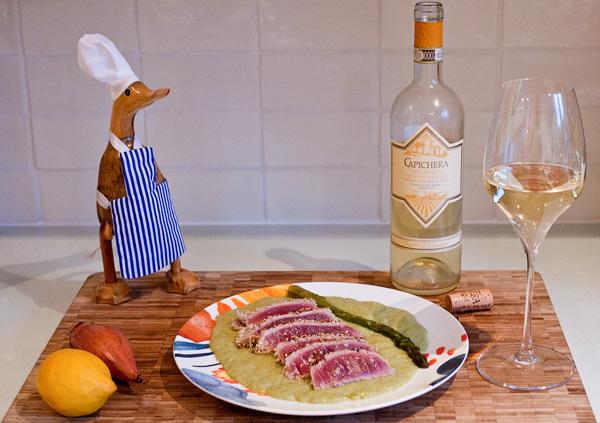A tuna and asparagus Mediterranean recipe for the summer. Paired with a Vermentino di Gallura and other favourite wines
In hindsight, I realise I was bound to cook this recipe. It was a lazy Saturday morning in London. As per my routine, I went out for my weekly shopping. My first stop: My local fishmonger. He had tuna fillets so red and thick that I almost wanted to eat it raw. I had to buy a few pieces. Next, the fruit and vegetables store. Perky green asparagus captured my attention. It was like they stared at me so I got a couple of bunches.
As soon as I stepped outside the shop, the sun broke up the clouds of what had previously been a typically grey day (hey, I am in London after all!). While the light warmed my skin, my mind wandered along a Mediterranean path. Suddenly inspired, I knew what I wanted to cook for dinner. The ingredients were already in the bag. I only had to connect the dots…
Asparagus and Tuna – Bites of Mediterranean history
Tuna fillet in sesame crust on a bed of asparagus vellutata. This recipe is inherently Mediterranean (though the sesame gives it an oriental touch).
The first traces of asparagus date back 2000 years. Then it was cultivated in a few Mediterranean areas (most notably in Egypt and Turkey). Asparagus surged in popularity during the Roman Empire. Numerous accounts indicate that the Latins particularly enjoyed the earthy salty-and-bitter taste of this vegetable.
Tuna is probably the most eaten fish in Mediterranean cuisine. In the Sicilian city of Trapani, prehistoric stone carvings of tuna can be found. In Ancient times, authors such as Aristotle, Plinius and Plutarch praised the many qualities of tuna. This rich and meaty fish has always been a Mediterranean staple especially in the Italian regions of Sicily and Sardinia.
It may not surprise you that I chose to pair this dish with an Italian white from Sardinia. A Vermentino di Gallura to be more precise. It’s produced by a leading Sardinian winemaker: Capichera. There are many reasons why this pairing works. I will explain why later on. Now, it’s recipe time!
The recipe
This dish consists of two parts: the tuna fillet and the asparagus vellutata (pureed soup). The two components can be prepared at different times. You can cook the vellutata the previous day and warm it up when you are ready to eat the tuna. The asparagus vellutata has a cooking and preparation time of 40 minutes, while the tuna fillet is much less (apart from the optional marinade) – around 10 minutes I would say. The ingredients below should be enough for 4 people.
Ingredients for the asparagus vellutata
- 500g of green asparagus
- 250g of potatoes
- 6 tbsp of extra virgin olive oil
- 1 big shallot
- 400ml of vegetable stock
- 100 ml of whole milk
- 40g of grated parmesan cheese
- Salt and pepper
Ingredients for the tuna fillet
- Fresh tuna fillets (around 600 g)
- Sesame seeds (30 g)
- Breadcrumb (30 gr)
- Salt and pepper
Ingredient for tuna marinade (optional)
- 7 tbsp of extra virgin olive oil
- 8 tbsp of grapefruit juice
- 4 tbsp of white wine
- 1 tbsp of soya sauce
- 1 tbsp of worcester sauce
- 3 garlic cloves – finely diced
- Some Mediterranean spices (dill, sage, black pepper)
- Salt
Marinade of the tuna (optional)
This is an optional step of the recipe, but I do recommend it. Marinade gives extra juiciness and flavours to the tuna fillet. If you choose to marinate your tuna, this step should be the first thing you do as it will need t be left for 1 to 2 hours.

Pour in a large container the olive oil, grapefruit juice, white wine, soya sauce, worcester sauce and add the chopped garlic and spices. Mix gently. Place the tuna fillets in the marinate. Turn the tuna so the marinade coats the entire surface. Transfer the tuna fillets and the marinade into a plastic bag. Make sure you stand the fillets in a horizontal position in the bag and that they are soaked by the marinade. Close the plastic bag and put it in the fridge for 1 or 2 hours.

Marinade
There are many ways you can marinade tuna. I opted for a prevalence of olive oil and grapefruit, but you can choose other ingredients. As a general rule, a marinade should always contain 1 part fat (oil, butter, etc.) and 2 parts acid (lemon, wine, soya, vinegar, etc.). You can add all the spices you want then.
Asparagus vellutata
This is the lengthy part of the recipe – but I assure you it’s worth it. I will break down the steps involved, with some pictures to make the process easier.
1. Gather everything you need for the vellutata: asparagus, potatoes, shallot (or white onion), vegetable stock as per following picture

2. Finely dice a shallot. Roughly chop the asparagus and potatoes. If you want you can leave a couple of asparagus whole and use them to decorate your soup at the end
3. Add olive oil to a large saucepan and turn the hob on to a medium heat. After a minute, add the finely diced. Stir gently
4. When the shallot turns yellow (see picture), add the chopped asparagus and potatoes. Stir for a couple of minutes

5. Add vegetable stock to the pan; the liquid should cover everything. If you have kept any whole asparagus for decoration add these to the pan

6. Turn the heat down a little, cover the pan with a lid. Let everything cook for 15-20 minutes
7. Remove the lid and any whole asparagus from the pan.
8. Add whole milk and cheese to the pan then blend the mixture to a smooth thick soup, using a hand blender (see following picture)

9. Your vellutata is ready! Let it rest for a few minutes; you can also leave it overnight and warm it up when necessary
Tuna fillet with sesame crust
1. On a flat dish, combine sesame seeds, breadcrumbs and a pinch of salt and black pepper.

2. Take the marinated tuna out of the fridge. If you didn’t marinate the tuna, make sure you rub olive oil into all over the surface of the tuna
3. Roll each piece of tuna fillet into the mixture, making sure all the meat surfaces are covered

4. Put a tablespoon or two of olive oil into a non-stick frying pan. Turn the heat on to high
5. Once the oil is hot, add the tuna pieces to the pan.

6. Let the tuna fillets cook for 1 or 2 minutes for each side (no more); then remove the fillets from the pan
Time to put it all together
- Remove the cooked tuna fillets from the pan and place on a chopping board.
- Slice the tuna fillets into 1-2 cm thick slices (the tuna should still be raw in the middle)
- On a flat dish, spoon a generous amount of asparagus vellutata onto each place.
- Place the cooked whole asparagus over the soup for decoration
- Gently lay the sliced tuna fillet pieces on top of the asparagus vellutata
- Congratulate yourself – you made it!

Wine pairing
As I mentioned at the beginning of the article, I chose to pair my tuna fillet in a sesame crust and asparagus vellutata with a Vign’Angena Vermentino di Gallura by Capichera. The pairing works well for a number of reasons.
The Capichera Vermentino is aromatic, persistent, high in acidity and with a marked saline minerality. The wine’s citrusy and herbal nuances makes it a good partner for the earthy aspect of asparagus. It also marries well with the salty-and-bitter flavours of the asparagus (a food notoriously difficult to pair), matching its acidity and complementing the vegetable’s sour and bitter edge. The vermentino is quite concentrated and full in body and is therefore perfectly capable of withstanding the strong and fleshier texture of the tuna fillet.
Generally, vermentino is a versatile wine when it comes to food pairing. This Vermentino di Gallura features an extraordinary saline minerality, that makes it a perfect pairing with anything coming from the sea.
Capichera - Vigna'ngena Vermentino di Gallura, 2017

 Country: Italy
Region/appellation: Sardinia - Vermentino di Gallura DOCG
Wine style: Dry white - Tropical and Balanced
Grape(s): Vermentino
Average price: £24
Country: Italy
Region/appellation: Sardinia - Vermentino di Gallura DOCG
Wine style: Dry white - Tropical and Balanced
Grape(s): Vermentino
Average price: £24
In the mid-1970s the Ragnedda family founded the Capichera winery in Arzachena, the heart of Gallura (the northern part of Sardinia). This is the homeland of vermentino, whose fame and relevance the Ragnedda family has greatly contributed.
The estate’s philosophy towards winemaking is focused on the vineyards rather than the winery. They limit human intervention and the plants’ health takes precedence over commercial needs.
This wine “Vign’Angena” is probably the best expression of the vermentino grape by Capichera. In the local dialect “Vign’Angena” means “foreign vineyards”. This is because the wine was originally made from grapes sourced from vineyards that Capichera managed but did not own. These plots were then purchased by Capichera over the years.
Tasting notes
(tasted on: 15-Jun-2019)
The wine has a lemon-straw brilliant hue that is pale in intensity. On the nose, it opens up with an intense and juicy fruitiness. Notes of grapefruit and lemon are laced with nectarine and yellow plums, followed by notes of yellow flowers – iris, hawthorn and orange blossom. Hints of pineapple and dried herbs provide added complexity. But, above all, what strikes the drinker is the intense saline minerality of the wine and this is affirmed by the swirling scents of seaweed, salty rocks and seashells.
On the palate, the intense iodine minerality is confirmed. The body is medium to full, and the flavours are both intense and fresh (thanks to a lively high acidity). After a lemony attack, some riper fruit notes emerge: grapefruit, nectarines and pineapple. In the mid-palate, the marked iodine minerality takes over as if chewing raw seafood still imbibed with the salty water of the Mediterranean. Overall, this wine has good concentration and balance on the palate. Aromatic, fresh, it is very mineral and intense. The finish is not very long but it’s still remarkable thanks to its distinctive seaweed minerality.
Wine and other Stories rating: 8.8/10
Other recommended wine pairings
Here are other wines you can pair with this recipe:
- Other vermentino wines (good examples comes from Liguria and Tuscany in Italy, or from Provence, where this grape is called rolle)
- Dry muscats from Alsace
- Sauvignon-Semillon dry blends, especially from the Left Bank of Bordeaux or Western Australia (notably Margaret River)
- A Chablis Premier Cru or a similar unoaked chardonnay with some body
- Sancerre or Pouilly Fumé from France’s Loire Valley
- Grüner Veltliner from Austria
Let me know in the comment section if you tried this recipe and which wine you paired it with. Also, if you have any suggestions to improve this recipe, please share them. Buon appetito!

